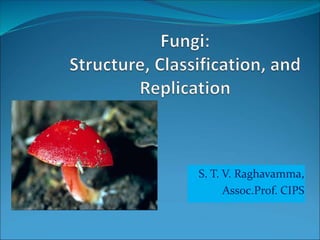
(10) Fungal Classification, Structure, and Replication.ppt
- 1. S. T. V. Raghavamma, Assoc.Prof. CIPS
- 2. Features of Fungi and its value in our life: The fungi are a ubiquitous and diverse organisms, that degrade organic matter. Fungi have heterotrophic life; they could survive in nature as: Saprophytic: live on dead or decaying matter Symbiotic: live together and have mutual advantage Commensal: one benefits and other neither benefits nor harmed. Parasitic: live on or within a host, they get benefit and harm the other. Fungi mainly infect immunocompromised or hospitalized patients with serious underlying diseases. The incidence of specific invasive mycoses continues to increase with time The list of opportunistic fungal pathogens likewise increases each year “It seems there are no non-pathogenic fungi anymore ! “ This increase in fungal infections can be attributed to the ever- growing number of immunocompromised patients.
- 3. Fungal Taxonomy: Kingdom Fungi (Myceteae) 5 main classes of medically important fungi. 1. Zygo - mycetes, 2. Asco - mycetes, 3. Archiasco - mycetes, 4. Basidio - mycetes 5. Deutero - mycetes
- 4. Fungal Morphology and Structure Eukaryotic organisms, distinguished by a rigid cell wall composed of chitin and glucan, and a cell membrane in which ergosterol is substituted for cholesterol as the major sterol component. Fungal taxonomy relies heavily on morphology and mode of spore production Fungi may be unicellular or multicellular. The simplest grouping based on morphology divides fungi into either yeast or mold forms.
- 5. 1- Yeast can be defined morphologically as a cell that reproduces by budding or by fission. Daughter cells may elongate to form sausage-like pseudohyphae.
- 6. 2- Moulds are multicellular organisms consisting of threadlike tubular structures called Hyphae that elongate by apical extension. Hyphae are either: Coenocytic: hollow and multinucleate Septate: divided by partitions or cross-walls Hyphae form together to produce a mat-like structure called a Mycelium. Vegetative hyphae, grow on or under surface of culture medium, Aerial Hyphae: project above surface of medium Aerial H. produce Conidia (asexual reproductive elements) Conidia can easily airborne and disseminate the fungus. Many medical fungi are termed dimorphic because they exist in yeast and mould forms.
- 8. Asexual spores consist of two general types: 1) sporangiospores and 2) conidia. Sporangiospores are asexual spores produced in a containing structure or sporangium ( in class Zygomycetes: as Rhizopus and Mucor spp.) Conidia are asexual spores that are borne naked on specialized structures (Aspergillus, Penicillium, and the dermatophytes).
- 9. Aspergillus niger conidiophore and conidia Dermatophyte conidia Penicillium conidia
- 11. Physiology Most fungi are Aerobic, some are facultative anaerobic, or strict anerobic. Fungi are heterotrophic and biochemically versatile: Primary metabolites: citric acid, ethanol, glycerol Secondary : antibiotics [as penicillin], and aflatoxins. Fungi are slow growing with cell-doubling times in hours. Fungi reproduce by formation of spores, which may be sexual (teleomorph), or asexual (anamorph): Fungi in class: Zygomycetes, Ascomycetes, Archiascomycetes, and Basidiomycetes produce both sexual and asexual spores. Histoplasma capsulatum (anamorph) and Ajellomyces capsulatum (teleomorph) are two forms of same fungus !!
- 12. The 5 Medical Fungal Classes 1) ZYGOMYCETES: Moulds with broad, sparsely septate, coenocytic hyphae. Zygomycetes produce sexual zygospores following the fusion of two compatible mating types. The asexual spores of the order Mucor are contained within a sporangium (sporangiospores, see figure.. ) The sporangia are borne at the tips of stalk-like sporangiophores that terminate in a bulbous swelling called the columella The presence of root-like structures, called Rhizoids, is helpful in identifying specific genera within the Mucorales. (see next figure )
- 14. Zygomycetes: medical significance This group, having a worldwide distribution, may be found in soil or decaying vegetable matter. They may also be found on stored grain, fruits and vegetables, compost, and air. They are generally associated with warmer climates. They may be allergenic and are known to cause opportunistic infections in immunocompromised individuals. This group includes : Absidia , Rhizopus and Mucor. Mucor
- 15. Absidia A Zygomycete, it has been reported to be allergenic. It may cause zygomycosis (an opportunistic fungal infection) and mycotic keratitis (an opportunistic fungal infection of the cornea). Absidia can cause serious infections in individuals who are malnourished, in diabetic acidosis, or immunocompromised.
- 16. 2) ASCOMYCETES Ascomycetes include yeasts and moulds. The hyphae are septate Asexual spores conidiophores. Sexual spore of called “ascospore”, found within a sac or ascus.
- 17. Fluffy, filamentous growth of a saprophytic mucor on a peach. Yeast colonies on agar
- 18. 3) ARCHIASCOMYCETES Archiascomycetes is a new class that was recently described to include an organism, Pneumocystis carinii, that had formerly been considered a protozoan. The organism exists in a vegetative, trophic form that reproduces asexually by binary fission. Fusion of compatible mating types results in a spherical cyst or spore case, which on maturity contains eight spores.
- 20. 4) BASIDIOMYCETES Basidiomycetes are rarely encountered clinically. The only human pathogen is Cryptococcus neoformans. The sexual spore is called basidiospore, characterized by the extension from a club-shaped structure, the basidium (see figure above).
- 21. Have both yeasts and mould forms. No sexual phase. Many of pathogenic fungi are included in this class. They have septate hyphae and produce conidia from conidiophores and conidiogenous cells. The yeasts reproduce by budding, and the moulds produce conidia by either a blastic (budding) process or a thallic process, in which hyphal segments fragment into individual cells or arthroconidia. 5) DEUTEROMYCETES
- 22. Macroconidia of dermatophyte (Microsporum canis)
- 23. Arthroconidia